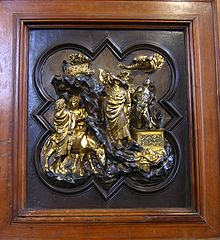Competitive reliefs
The so-called competition reliefs are two bronze specimens Lorenzo Ghiberti and Filippo Brunelleschi for 1401 in Florence advertised competition for the design of the second bronze portal of the Baptistery of Florence Cathedral . According to the jury, Ghiberti won and was awarded the contract for the door, which he was to work on for more than two decades. Both reliefs are now kept in the Bargello .
Historical context
In 1401 the Arte di Calimala , the Florentine guild of money changers, put out the contract for the successor to the first door of the Baptistery, which was created by Andrea Pisano from 1330 . Reliable documents about the competition do not exist; according to Ghiberti and Antonio Manetti's biography Brunelleschi, Jacopo della Quercia , Francesco di Valdambrino , Simone da Colle Val d'Elsa , Niccolò di Luca Spinelli and Niccolò di also applied in addition to the two then almost unknown sculptors Piero Lamberti . It is unclear whether all artists were selected to use the bronze material provided to make samples on the given theme of the sacrifice of Isaac . Only the two reliefs Ghibertis and Brunelleschi have survived. After Ghiberti won, both works were probably installed first in the Palazzo dell'Arte dei Mercatanti and then in the Old Sacristy of San Lorenzo , where they decorated an altar. It was not until the 18th century that the works came separately to the Uffizi and from there to the Bargello.
description
While the size (approx. 45 × 38 cm) and format (a quatrefoil with an inscribed square ) of the two reliefs differ only imperceptibly and the number of figures (four people, one angel and two animals) is identical, Ghiberti's work differs in the significantly lower weight (18.5 compared to 25.5 kilograms), which suggests a more technically experienced design: Richard Krautheimer calculated that if Brunelleschi's hypothetical door had been made in an analogue process, it would have been around 600 pounds heavier and therefore significantly more expensive for the client.
Both pictorial solutions contain ingenious references to ancient designs and famous models, whereby they are used more prominently by Brunelleschi and appear as direct quotations above all in the copy of the mandrel extractor . While he creates a horizontal structure, Ghiberti's quatrefoil relief is divided diagonally and the dynamic is emphasized by individual motifs such as Abraham's raised arm. Nevertheless, his composition appears overall more balanced and self-contained due to the flow of the landscape, whereas Brunelleschi's carefully studied individual elements seem isolated and not connected to one another. Another difference is the narrative reading flow: With Ghiberti, the viewer follows the action from left to right, while Brunelleschi depicts the dramatic climax of the action, the intervention of the angel, on the left-hand side and thus according to European viewing traditions at the “beginning of reading” .
Historical evaluation
Although competitions were not uncommon in the late Middle Ages and the Renaissance, the 1401 announcement is considered an important turning point. The different stylistic solutions that are understandable due to the preservation of the sample pieces, the relationship between artistic tradition and references to the recently rediscovered antiquity as well as the historiographical classification by early authors such as Manetti, Giorgio Vasari and Ghiberti himself have made the two competing designs a paradigm, which in the 20th century has become a classic of art historical comparative exercises. Another reason for the interest in the two competing reliefs is likely to be the ongoing employment relationship between Ghibertis and Brunelleschis, who on the one hand collaborated with each other as master builders for the cathedral, but on the other hand continuously fought for the hierarchy on the construction site and repeatedly for their supremacy in subsequent tenders such as the dome construction of the cathedral should fight. As a result, it was mostly Brunelleschi who was to keep the upper hand in the architectural projects.
literature
- Richard Krautheimer , Trude Krautheimer-Hess : Lorenzo Ghiberti (= Princeton Monographs in Art and Archeology. Vol. 31, ZDB -ID 419074-9 ). Princeton University Press, Princeton NJ 1956.
- Hanno Rauterberg : The competitive reliefs : Brunelleschi and Ghiberti in the competition for the Baptistery door in Florence. Lit, Münster, ISBN 3-8258-2738-0 .
Individual evidence
- ↑ Krautheimer 1956, p. 46.

